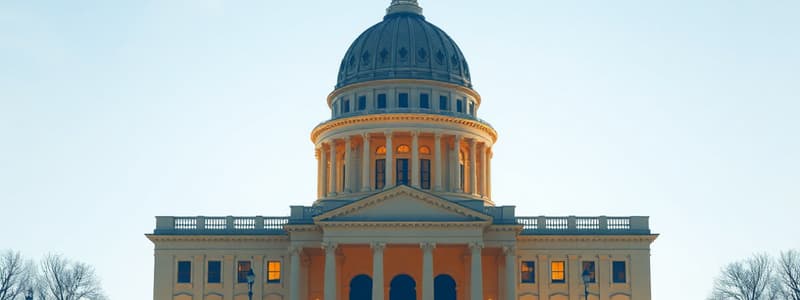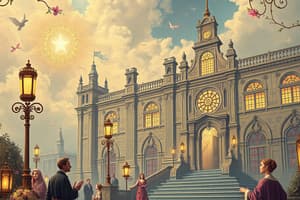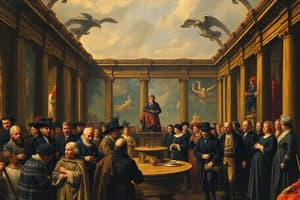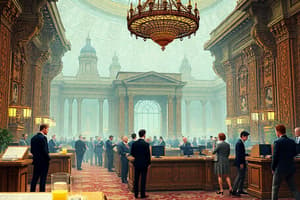Podcast
Questions and Answers
The provided information suggests that the federal bureaucracy has consistently grown over time.
The provided information suggests that the federal bureaucracy has consistently grown over time.
False (B)
Which of the following best describes the primary role of federal bureaucrats?
Which of the following best describes the primary role of federal bureaucrats?
- Elected officials responsible for policy making
- Career government employees working in the executive branch (correct)
- Political appointees who serve at the pleasure of the president
- Members of Congress who oversee government agencies
Besides executive departments and independent agencies, name another significant employer of federal civilian workers.
Besides executive departments and independent agencies, name another significant employer of federal civilian workers.
U.S. Postal Service
Federal employees are typically paid according to the '________ ________' (GS).
Federal employees are typically paid according to the '________ ________' (GS).
Which president proposed a plan to consolidate numerous domestic agencies into 'super departments'?
Which president proposed a plan to consolidate numerous domestic agencies into 'super departments'?
Which action did the Clinton administration take to reform the bureaucracy?
Which action did the Clinton administration take to reform the bureaucracy?
The number of federal workers includes uniformed military personnel.
The number of federal workers includes uniformed military personnel.
Match the president with their bureaucratic reform efforts:
Match the president with their bureaucratic reform efforts:
What is the PRIMARY criterion used to select most civilian federal governmental employees today?
What is the PRIMARY criterion used to select most civilian federal governmental employees today?
What is the primary driving force for private businesses, as opposed to government entities?
What is the primary driving force for private businesses, as opposed to government entities?
Merit systems protect federal employees from being fired for poor performance.
Merit systems protect federal employees from being fired for poor performance.
Governments can learn nothing from business practices.
Governments can learn nothing from business practices.
What types of examinations are mentioned as examples of merit-based selection?
What types of examinations are mentioned as examples of merit-based selection?
What is an important consideration when initiating positive change in the modern bureaucracy?
What is an important consideration when initiating positive change in the modern bureaucracy?
At the lower levels of the U.S. Civil Service, most positions are filled by ________ examinations.
At the lower levels of the U.S. Civil Service, most positions are filled by ________ examinations.
One of the primary differences between government and business is that government is funded by ________.
One of the primary differences between government and business is that government is funded by ________.
Which of the following application methods is MOST likely to be used for mid-level to upper-range federal positions?
Which of the following application methods is MOST likely to be used for mid-level to upper-range federal positions?
Why do public employees typically view risks and rewards differently compared to their private-sector counterparts?
Why do public employees typically view risks and rewards differently compared to their private-sector counterparts?
The names of all those deemed qualified are forwarded to the official filling the vacancy regardless of how well they fit the particular job opening.
The names of all those deemed qualified are forwarded to the official filling the vacancy regardless of how well they fit the particular job opening.
Approximately what percentage of the federal workforce is NOT covered by the civil service system?
Approximately what percentage of the federal workforce is NOT covered by the civil service system?
Match the following:
Match the following:
Besides Cabinet secretaries, which of the following positions requires Senate confirmation?
Besides Cabinet secretaries, which of the following positions requires Senate confirmation?
What aspect of the modern bureaucracy is key to understand?
What aspect of the modern bureaucracy is key to understand?
The size of state and local bureaucracies has remained constant over time.
The size of state and local bureaucracies has remained constant over time.
What is a primary reason the federal government might choose to use outside contractors instead of federal employees?
What is a primary reason the federal government might choose to use outside contractors instead of federal employees?
The number of civilian agencies in the federal government is estimated to be less than 500.
The number of civilian agencies in the federal government is estimated to be less than 500.
Name two strategies the federal government is considering to attract and retain federal workers.
Name two strategies the federal government is considering to attract and retain federal workers.
Cabinet departments constitute approximately ______ percent of the federal workforce.
Cabinet departments constitute approximately ______ percent of the federal workforce.
What is a distinctive feature of the executive bureaucracy?
What is a distinctive feature of the executive bureaucracy?
Which of the following is NOT a general type of agency?
Which of the following is NOT a general type of agency?
Departmental status usually indicates what about a governmental function?
Departmental status usually indicates what about a governmental function?
Match the following types of agencies with their descriptions:
Match the following types of agencies with their descriptions:
Once appointed, how does a commissioner's relationship with the president typically evolve?
Once appointed, how does a commissioner's relationship with the president typically evolve?
The U.S. Postal Service currently has a large number of patronage positions such as local postmaster, available as government jobs.
The U.S. Postal Service currently has a large number of patronage positions such as local postmaster, available as government jobs.
What is the primary purpose of the U.S. bureaucracy's decentralization into regional offices?
What is the primary purpose of the U.S. bureaucracy's decentralization into regional offices?
Having regional offices in different cities helps distribute jobs and across the country.
Having regional offices in different cities helps distribute jobs and across the country.
Match the agency characteristic with its effect:
Match the agency characteristic with its effect:
What is one of the effects of the decentralization of the U.S. bureaucracy?
What is one of the effects of the decentralization of the U.S. bureaucracy?
The Presidential Management Fellows Program was created to address the potential shortfall in experienced managers due to the aging federal workforce.
The Presidential Management Fellows Program was created to address the potential shortfall in experienced managers due to the aging federal workforce.
What concern does the 'graying' of the federal workforce raise?
What concern does the 'graying' of the federal workforce raise?
Flashcards
Modern Bureaucracy
Modern Bureaucracy
The system of administration in government and business organizations that follows rules and procedures to manage operations.
Private Business vs Government
Private Business vs Government
Private businesses operate for profit while governments exist for public good and services.
Profit Motive
Profit Motive
The incentive for businesses to generate financial gains through sales and services to customers.
Reelection
Reelection
Signup and view all the flashcards
Incentives in Government
Incentives in Government
Signup and view all the flashcards
Bureaucratic Organization
Bureaucratic Organization
Signup and view all the flashcards
Accountability in Government
Accountability in Government
Signup and view all the flashcards
Learning from Business
Learning from Business
Signup and view all the flashcards
Federal Bureaucracy
Federal Bureaucracy
Signup and view all the flashcards
Bureaucrats
Bureaucrats
Signup and view all the flashcards
General Schedule (GS)
General Schedule (GS)
Signup and view all the flashcards
Federal Workforce Size
Federal Workforce Size
Signup and view all the flashcards
Reform Efforts
Reform Efforts
Signup and view all the flashcards
Clinton Administration
Clinton Administration
Signup and view all the flashcards
George W. Bush's Initiatives
George W. Bush's Initiatives
Signup and view all the flashcards
U.S. Postal Service
U.S. Postal Service
Signup and view all the flashcards
Merit Standards
Merit Standards
Signup and view all the flashcards
Civil Service Exams
Civil Service Exams
Signup and view all the flashcards
Firing Protections
Firing Protections
Signup and view all the flashcards
Lower-level Positions
Lower-level Positions
Signup and view all the flashcards
Mid-level Hiring
Mid-level Hiring
Signup and view all the flashcards
Appointive Policy-making Positions
Appointive Policy-making Positions
Signup and view all the flashcards
Independent Regulatory Commissioners
Independent Regulatory Commissioners
Signup and view all the flashcards
Bureaucratic Hierarchy
Bureaucratic Hierarchy
Signup and view all the flashcards
Commissioners
Commissioners
Signup and view all the flashcards
Political Patronage
Political Patronage
Signup and view all the flashcards
Decentralization
Decentralization
Signup and view all the flashcards
Social Security Administration
Social Security Administration
Signup and view all the flashcards
Aging Workforce
Aging Workforce
Signup and view all the flashcards
Presidential Management Fellows Program
Presidential Management Fellows Program
Signup and view all the flashcards
Federal Workforce Distribution
Federal Workforce Distribution
Signup and view all the flashcards
Mid-level Managers
Mid-level Managers
Signup and view all the flashcards
Federal Employee Outsourcing
Federal Employee Outsourcing
Signup and view all the flashcards
Cabinet Departments
Cabinet Departments
Signup and view all the flashcards
Civilian Agencies
Civilian Agencies
Signup and view all the flashcards
Division of Specialization
Division of Specialization
Signup and view all the flashcards
Long-term National Interest
Long-term National Interest
Signup and view all the flashcards
Recruitment Incentives
Recruitment Incentives
Signup and view all the flashcards
Job Security in Federal Jobs
Job Security in Federal Jobs
Signup and view all the flashcards
Federal Workforce Composition
Federal Workforce Composition
Signup and view all the flashcards
Study Notes
Modern Bureaucracy
- The study is about modern bureaucracy, focusing on differences between private businesses and government
- Private businesses aim for profit, motivated by customer satisfaction
- Government prioritizes public service and reelection, funded by taxpayers
- Difficulty assigning blame for governmental mistakes, a problem contrasted with private businesses
- Governments can learn from successes and failures of business in terms of reform
- Government incentives focus on avoiding mistakes, whereas private sector views risks and rewards differently
- Key to modern bureaucracy is understanding bureaucratic structure, personnel, and how they affect each other
- Running government like a business is inappropriate due to inherent differences in motivation, responsibility, and organizational structure
- Growth of state and local bureaucracies, contrasted with discussion limited to the federal bureaucracy
- Historical attempts to reform the bureaucracy include cuts in staff, combining departments, regulations, and customer service improvements
- Bureaucrats are career government employees working in the executive branch, Cabinet-level departments, and independent agencies
- Federal workers are distributed among different executive departments and agencies across the United States
- Most federal employees are paid based on the General Schedule (GS) levels, increasing with progression in their careers
- Federal employees are selected based on merit standards including tests and educational criteria, protecting them from political firings
- Lower level positions in the U.S. Civil Service are frequently filled by competitive examinations
- Mid-level to upper-level positions may use resume submission or phone application instead of tests
- Personnel departments evaluate candidates based on their fit for the job opening
- Appointive policy-making jobs are filled by presidential appointees, who are often Cabinet Secretaries requiring Senate confirmation
- Independent regulatory commissions are appointed by the president, but become independent after taking office
- Low-level bureaucratic positions such as local postmasters were once largely patronage positions; this has generally changed to positions like assistance to policy makers
- About 326,000 federal workers are located in the nation's capital, and the rest are distributed among regional, state and local offices across the country
- Decentralization facilitates public access to services and distribute jobs and income across the country
- A significant portion of top-level federal employees are eligible for retirement
- Federal government tries to retain and recruit workers, as well as reduce the number of employees using contractors
- Government agencies are considering paying college loans for recruits and offering benefits to attract older workers
- Agencies aim to outsource jobs to reduce costs
- The Federal bureaucracy is comprised of departments, government corporations, independent agencies, and regulatory commissions
- Cabinet departments focus on broad areas of government operations, indicating a long-term national concern like defense, commerce, or agriculture
- Bureaucracy is made up of agencies and institutions that implement government policies, programs, and laws
Studying That Suits You
Use AI to generate personalized quizzes and flashcards to suit your learning preferences.




